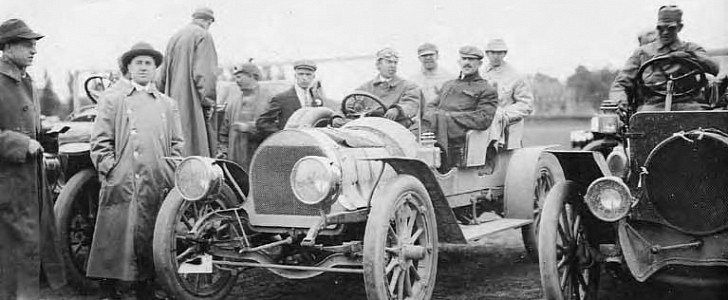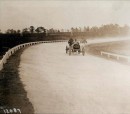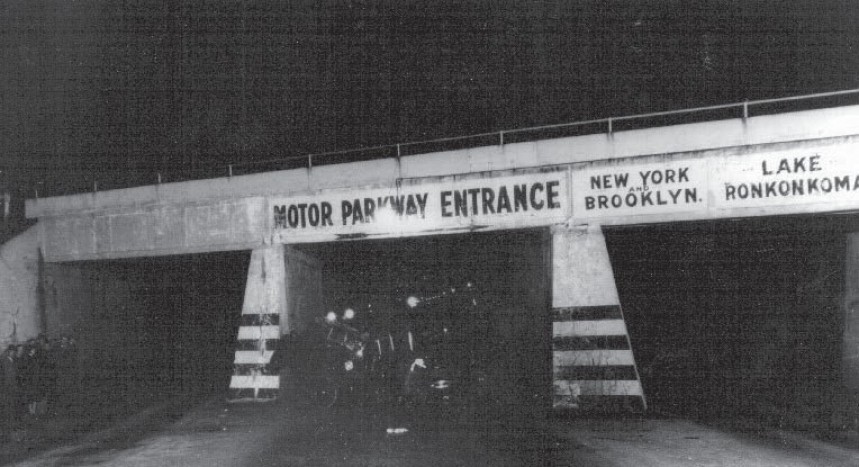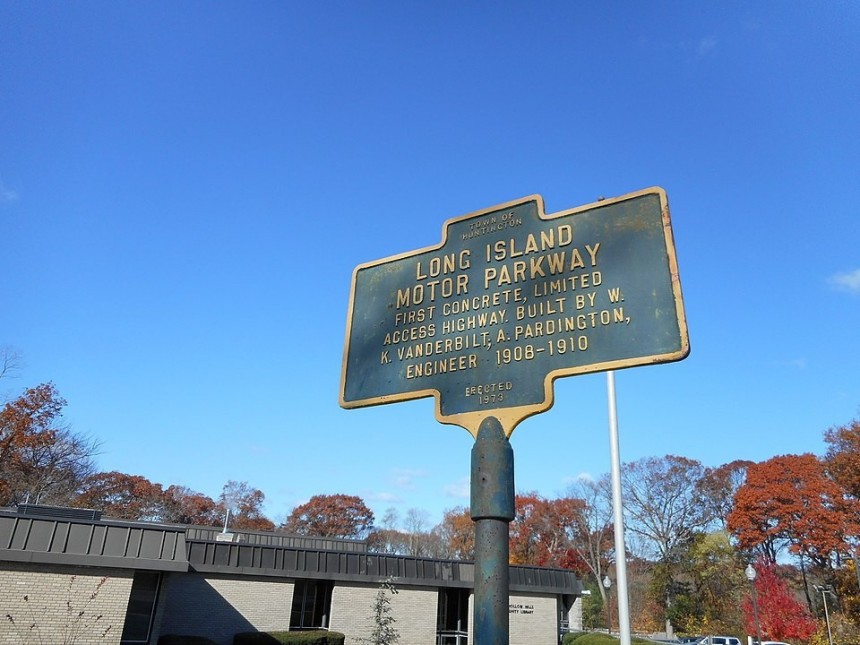Americans are a people constantly on the move. Be it to work and back, cross country on vacation, or just because they enjoy the freedom of life on the road. But roads dedicated to automobile use first and everything else second had their start, not in Detroit or Southern California. But in metropolitan New York.
You'd be forgiven for not having a single clue about the Long Island Motor Parkway. It doesn't quite roll off the tongue like Old U.S. Route 66, does it? Well, before the idea of federal highways was a glimmer in the eye of U.S. public works leaders, this privately funded stretch of asphalt was as close as you could get to life being a highway and wanting to ride it all night long. Although being that this was also a toll road, that could probably get expensive.
Say hello to William Kissam Vanderbilt II, a name that rolls right off the tongue, yet again. (Not!) Absurdly snooty birth name aside, there was a lot to admire about this sporting aristocrat alive over a century ago. He was one of the world's very first petrolheads of the speed freak variety. Perhaps the very first in North America. He was the great-grandson of Cornelious Vanderbilt, a Staten Island, New York native who cemented his family name forever with his vast railroad industry fortune.
William Vanderbilt, or just Vanderbilt, as we'll call him from now on, was a fan of all forms of racing. Be it running, horse racing, sailing, and of course, auto racing. With the kind of family reserves he had to throw around, he had the moolah to blow to make his racing dreams a reality. It started with the Vanderbilt Cup, the first American automobile race of any significance in history, in 1904.
William Vanderbilt and his well-to-do buddies spent much of their free time cruising, and often racing around the many residential streets of Nassau County, just east of New York City proper. And remember, automobiles of the early 1900s were comically unsafe contraptions with unintuitive controls. The only crumple zone in a significant impact was your face, to boot.
The horse manure from the carriages using these Long Island streets only added an extra foul-smelling layer of danger to what Vanderbilt was getting up to. It was only a matter of time before somebody was killed, and people did die during one of Vanderbilt's impromptu race events that claimed the lives of a driver and two spectators.
It was at this point that Vanderbilt knew something had to change. Not willing to let the spirit of speed die in New York, he proposed something radical in the day. A bespoke road, just for cars. No horses dropping manure everywhere, no residential streets to terrorize with light-hearted competitive racing.
Vanderbilt's road was initially slated to run a staggering 70 miles. Not much by modern highway standards, granted. But by early 1900s standards, a journey like that by car might as well have been the Cannonball Run. The 45 mile stretch of road Vanderbilt ultimately settled with wasn't much less impressive, especially for the period.
It spanned a plethora of local communities like Garden City, Bethpage, Plainview, and Levittown in Nassau County. But also towns in Suffolk County like Dix Hills, Central Islip, East Brentwood, and Ronkonkoma. That's without counting the many yet developed neighborhoods in the New York City borough of Queens that also found their way onto the westernmost portion of what was to be dubbed the Long Island Motor Parkway.
The finish line at the most eastern portion of the road reached its terminus just before the mouth of Lake Ronkonkoma in Suffolk County. Needless to say, bragging rights for whoever reached the end first was no small thing for Vanderbilt and his racing buddies.
Everything from the very earliest Fords to Oldsmobiles, Packards, Cadillacs, and Duesenbergs felt right at home on the smooth, paved road often named in the press after Vanderbilt himself. The names Long Island Motor Parkway and Vanderbilt Motor Parkway are often used interchangeably to refer to America's first road made for cars alone.
Parts of the parkway were used for the fledgling American Auto Association's first-ever sanctioned races. It's said as many as 300,000 spectators crammed were on hand to watch the landmark races in 1909 and 1910. Three consecutive races were held in the 1910 event on October 10th of that year. Sadly, during the 1910 event, an accident killed two mechanics and prompted New York State lawmakers to ban motor racing on public roads.
The parkway served as just another commuter road from then until the late 1930s. A toll as high as $2 was implemented during the early years of the road's use. This decreased to just under 50 cents by 1938. By that point, public officials deemed it too outdated for the grand public highway system slated to transform the way New Yorkers traveled by car.
The road was once donated to Nassau and Suffolk counties, which integrated sections into their larger public street network or recommissioned them as public bike paths. Today, there's still a plethora of places you could bike, jog, or even drive over throughout Queens, Nassau, and Suffolk County that you can go and travel on yourself.
But let's be real, none of that would be close to the thrill William Vanderbilt must have felt trying hurdling down the road in a horseless carriage with no seatbelts at 45 miles per hour. It's a mystery how even more people weren't killed.
Say hello to William Kissam Vanderbilt II, a name that rolls right off the tongue, yet again. (Not!) Absurdly snooty birth name aside, there was a lot to admire about this sporting aristocrat alive over a century ago. He was one of the world's very first petrolheads of the speed freak variety. Perhaps the very first in North America. He was the great-grandson of Cornelious Vanderbilt, a Staten Island, New York native who cemented his family name forever with his vast railroad industry fortune.
William Vanderbilt, or just Vanderbilt, as we'll call him from now on, was a fan of all forms of racing. Be it running, horse racing, sailing, and of course, auto racing. With the kind of family reserves he had to throw around, he had the moolah to blow to make his racing dreams a reality. It started with the Vanderbilt Cup, the first American automobile race of any significance in history, in 1904.
William Vanderbilt and his well-to-do buddies spent much of their free time cruising, and often racing around the many residential streets of Nassau County, just east of New York City proper. And remember, automobiles of the early 1900s were comically unsafe contraptions with unintuitive controls. The only crumple zone in a significant impact was your face, to boot.
It was at this point that Vanderbilt knew something had to change. Not willing to let the spirit of speed die in New York, he proposed something radical in the day. A bespoke road, just for cars. No horses dropping manure everywhere, no residential streets to terrorize with light-hearted competitive racing.
Vanderbilt's road was initially slated to run a staggering 70 miles. Not much by modern highway standards, granted. But by early 1900s standards, a journey like that by car might as well have been the Cannonball Run. The 45 mile stretch of road Vanderbilt ultimately settled with wasn't much less impressive, especially for the period.
It spanned a plethora of local communities like Garden City, Bethpage, Plainview, and Levittown in Nassau County. But also towns in Suffolk County like Dix Hills, Central Islip, East Brentwood, and Ronkonkoma. That's without counting the many yet developed neighborhoods in the New York City borough of Queens that also found their way onto the westernmost portion of what was to be dubbed the Long Island Motor Parkway.
Everything from the very earliest Fords to Oldsmobiles, Packards, Cadillacs, and Duesenbergs felt right at home on the smooth, paved road often named in the press after Vanderbilt himself. The names Long Island Motor Parkway and Vanderbilt Motor Parkway are often used interchangeably to refer to America's first road made for cars alone.
Parts of the parkway were used for the fledgling American Auto Association's first-ever sanctioned races. It's said as many as 300,000 spectators crammed were on hand to watch the landmark races in 1909 and 1910. Three consecutive races were held in the 1910 event on October 10th of that year. Sadly, during the 1910 event, an accident killed two mechanics and prompted New York State lawmakers to ban motor racing on public roads.
The parkway served as just another commuter road from then until the late 1930s. A toll as high as $2 was implemented during the early years of the road's use. This decreased to just under 50 cents by 1938. By that point, public officials deemed it too outdated for the grand public highway system slated to transform the way New Yorkers traveled by car.
But let's be real, none of that would be close to the thrill William Vanderbilt must have felt trying hurdling down the road in a horseless carriage with no seatbelts at 45 miles per hour. It's a mystery how even more people weren't killed.










